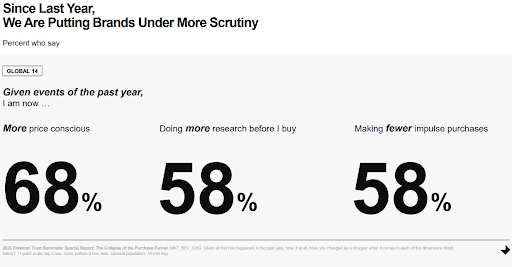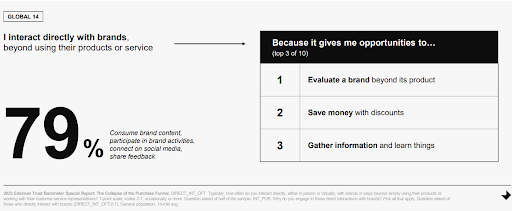SHARE

Successful brand engagement hinges on understanding the unique preferences and behaviours of Gen-Z and Millennial consumers. As digital natives, these demographics are technologically savvy, value-driven, and socially conscious.
Crafting a compelling digital branding strategy that resonates with modern consumers requires more than just a catchy tagline or a vibrant logo – they demand a deep understanding of their aspirations, concerns, and the channels they interact with.
This guide to digital branding for Gen-Z & X consumers will discuss the intricacies of building a resonant and authentic brand presence in the digital landscape. From decoding their digital preferences to uncovering elements that drive trust and loyalty, we explore how visual aesthetics, ethical values, and social impact converge.
Consumers Are Demanding Brand Transparency
When understanding Gen-Z and Millennials consumer behaviour, there’s a fundamental truth to grasp: trust is paramount.
These generations don’t easily spend money on brands that have yet proven their reliability. While buyer scepticism has always been around, it’s taken centre stage in 2023.
The past decade has been a rollercoaster for folks in the 21st Century. These events have imprinted on our collective consciousness, from natural calamities to economic fluctuations, the looming spectre of conflicts, and the digital impact of the COVID-19 pandemic.
 (2023 Edelman Trust Barometer Special Report: The Collapse of the Purchase Funnel)
(2023 Edelman Trust Barometer Special Report: The Collapse of the Purchase Funnel)
According to Edelman’s 2023 Trust Barometer, a thorough study spanning 14 countries with over 13,000 respondents, consumers are now keeping a closer eye on brands. This shift is evident in their cautious approach – they’re more conscious of prices, doing their homework before making purchases, and shying away from impulse buys. This signifies a turning point in 2023, debunking what brands and marketers once took for granted.
The marketing landscape is changing accordingly to accommodate these consumers. With immunity to old-school marketing tactics, they demand authenticity. As we move into this new era, marketing must adapt to meet their expectations, focusing on building genuine connections. After all, today’s consumers won’t settle for anything less.
How To Effectively Market To The Gen Z & Gen X Audience?
The excess of production that pollutes our oceans, the presence of unethical systems, and the spread of propaganda can no longer be swept under the rug. People are no longer willing to turn a blind eye. Recognising shifts in consumer behaviour within the marketing landscape has revealed that modern consumers are more discerning, refusing to align with brands, businesses, and products, disregarding the greater good.
However, it’s important to note that not all businesses, enterprises, and brands are villains. Many are working diligently to shift the paradigm to promote more responsible consumer behaviour. This article is a beacon for those who are open to listening, willing to consider the needs and concerns of the gen-z and gen-x buyers, and striving to provide a sense of reassurance.
Gen-Z Consumer Behaviour: Digital Trust Is Key
 (2023 Edelman Trust Barometer Special Report: The Collapse of the Purchase Funnel)
(2023 Edelman Trust Barometer Special Report: The Collapse of the Purchase Funnel)
The survey above shows that 79% of Gen-Z respondents are actively involved with brands. They’re consuming brand content, participating in brand-related activities, connecting on social media, and sharing their thoughts. And what’s driving all this interaction? Three main things: first, they want to size up a brand and determine if it’s worth their attention. Second, they’re exploring ways to save money and what brands offer. And third, they’re hungry for information – they want to know more about the products and services they’re interested in.
Gen-Z knows their way around the digital world and happily engages with brands to get these three things. Modern consumer buying behaviour answers every brand’s prayers – willingly diving into interactions to understand the brand and its products (or services).
-
Utilising Short-Form Video Platforms like TikTok
TikTok has become Gen Z’s playground for creativity and self-expression. Its bite-sized, engaging video content is a goldmine for marketers. The appeal lies in its succinct, engaging content that captures attention swiftly. Recognising this trend as a digital marketing expert opens up a treasure trove of brand opportunities.
You can effectively tap into this platform’s vast potential by crafting content that harmonises with TikTok’s dynamic and vibrant atmosphere while staying true to your brand’s core message. It’s not just about adapting to TikTok; it’s about embracing its spirited essence to seamlessly integrate your brand’s narrative and values into the hearts of Gen Z users.
-
Creating Authentic and User-Generated Content
Gen Z’s consumer buying behaviour results in a pursuit of authenticity, encouraging them to seek real, relatable stories and experiences that mirror their lives. In response, crafting content that rings true and resonates with their daily experiences can prove exceptionally impactful.
The power of user-generated content is that it empowers your audience to contribute their own perspectives and narratives.
This fosters a deeper sense of engagement and forges a community around your brand. By allowing your audience to become active co-creators of your content, you weave threads of authenticity and belonging, resulting in a more meaningful and lasting connection.
-
The Importance of Influencer Marketing
Influencer marketing holds sway over Gen Z’s purchasing decisions.
However, it’s crucial to recognise that authenticity is the key to success. Rather than pursuing collaborations purely for reach, the real potency emerges when you partner with influencers who inherently resonate with your brand’s values and ethos.
You create a narrative that feels free by granting them the creative liberty to craft content that aligns organically with their unique style and audience.
It’s a symbiotic relationship where the influencer’s authenticity dovetails seamlessly with your brand’s essence, effectively endorsing your product or service within a context that feels genuine to their audience.
This harmony between influencer, content, and audience establishes the credibility and trust that Gen Z values deeply, culminating in a more compelling and persuasive marketing strategy.
As a brand, embracing platforms like TikTok, fostering authenticity through user-generated content, leveraging influencer partnerships, and building trust through genuine interactions are pivotal in creating a lasting impact on this dynamic audience.
By tailoring your strategies to resonate with Gen Z’s values and preferences, you can position your brand for success in a landscape of meaningful connections and authentic engagement.
Consistently Promote and showcase Brand Values
Imagine scrolling through your favourite social media platform and seeing a brand talk about something they genuinely care about – like helping the environment or supporting a good cause. You start thinking, “Hey, this brand is more than just a business; they care about things that matter to me!”
That’s the magic of showcasing values.
Digital marketing guides, even those fancy AI-generated ones, consistently emphasise the same: brands should let people know what they stand for. It’s akin to wearing your heart on your digital sleeve. And here’s why it’s crucial:
- Building Trust: Consistency is important, especially in relation to familiarising target audiences with brand values and propositions. By consistently promoting, advocating and raising awareness across social media platforms, audiences get a glimpse of brand trustworthiness, compared to mainly posting about products and services, which may seem too hard-sell.
- Connecting with People: When you know what someone believes in, it’s easier to connect with them. The same principle applies to brands. When they discuss things that matter to people, it’s similar to striking up a conversation. On the other hand, more individuals would be able to relate since it’s a shared experience.
- Making a Difference: These days, people don’t merely want to buy stuff; they want to buy into a cause. People notice when a brand commits to something significant – reducing plastic waste or aiding needy communities. A display of conscientiousness, when performed correctly, will make your brand seem more approachable and make you the preferred choice in the long run.
Hence, when you witness brands spotlighting their values on social media, ads, and websites, it’s not just casual talk.
It’s a means for brands to express, “We care, we’re consistent, and we’re committed.” And that is how they capture hearts and evolve into more than just a brand – they become a meaningful part of people’s lives.
Purchase of Value, Value of Purchase
The digitally literate generation consumer behaviour is more likely to research a product before purchasing, including the market price and whether it’s a value for money.
Combat the curiosity and inquisitive nature of consumers by accommodating this digital literacy. Transparency matters a lot to people when the age of excess consumes and affects them daily. Approach the matter by ensuring the audience that the brand understands the concern and proactively encourage transparency.
Here’s a simple guide on how businesses can be more transparent and build trust with their customers:
- Product Value: Provide clear and comprehensive information when showcasing your products. Explain what your product does, its features, and how it can benefit your customers. Let them know exactly what they’re getting.
- Be Clear about Pricing: Display your product’s price prominently and ensure no hidden fees or surprises during checkout. Transparency in pricing builds trust and helps customers make informed choices.
- Share Customer Reviews: Positive feedback from other customers can speak volumes about your product’s quality. Share genuine customer reviews and testimonials on your website and social media platforms.
- Return and Refund Policies: Make your return and refund policies easy to find and understand. Let customers know how to return a product if unsatisfied and what the refund process entails.
- Address Common Questions: Create a frequently asked questions (FAQ) section on your website. Anticipate common questions that customers might have and provide clear answers. This shows that you’re attentive to their concerns.
- Offer Accessible Customer Support: Provide multiple ways for customers to contact your customer support team. This accessibility reassures customers that they can get assistance with questions or issues.
- Showcase Ethical Initiatives: Let your customers know if your business supports social or environmental causes. Many consumers appreciate and support businesses committed to making a positive impact.
Transparency is a cornerstone of contemporary consumer relationships.
The digitally literate generation demands candidness and authenticity. By embracing transparency, brands bridge the gap of scepticism, nurturing enduring trust and fostering a lasting bond with their audience.
Informative and Educational Content is All the Rage
With the influx of information readily available for anyone with access to the internet, consumers are more likely to appreciate and follow through with brands that educate them on product value even after the first purchase.
This is where brands can shine. Beyond the glitz of advertisements and the allure of offers, consumers are now drawn to brands that provide them with substance.
Brands that take the time to educate their audience are rewarded with something precious: loyalty.
So, if you’re a brand looking to stand out, remember this: being an educator sets you apart in a world of information. When you educate your customers, you don’t just sell to them; you invest in a partnership of growth and enrichment.
 Adidas Fosters Digital Trust Through Advocacy Campaigns
Adidas Fosters Digital Trust Through Advocacy Campaigns
https://www.instagram.com/reel/CslmlPOAOhY/?utm_source=ig_web_copy_link&igshid=MzRlODBiNWFlZA==
Adidas #MoveForThePlanet & #WithWomenWeRun
Brands like Adidas successfully incorporate ethical marketing in their strategy to win the hearts of consumers.
Championing campaigns with hashtags such as #MoveForThePlanet aims to donate up to €1.5 million to Common Goal Organisation, which seeks to improve and alleviate social challenges through Football-related initiatives. The brand intends to propel the audience into downloading the Adidas running app, but with 10 minutes of movement tracking, 1€ will be donated to the organisation.
It’s a win-win situation for all, the brand reaches its KPIs, and the consumers participate in changing the world through active sports.
Additionally, Adidas expresses its support for women’s sports by creating a separate Instagram account for Adidaswomen.
Their recent campaign highlights women’s challenges in a patriarchal society using the hashtag #WithWomenWeRun as a sign of solidarity. The campaign aims to raise awareness of women’s challenges when running at night.
The message is clear – women’s challenges deserve attention.
An alarming survey conducted by Runner’s World and Women’s Health underscores the importance of this stance. A staggering 60% of women said they had faced harassment while running. This isn’t just about raising awareness, addressing a stark reality, and creating change.
The takeaways from Adidas’ endeavours are profound. Ethical marketing is no longer a buzzword; it’s a catalyst for transformation.
Brands can wield their influence to drive meaningful change, aligning values with consumer aspirations. Adidas exemplifies that purpose-driven campaigns aren’t just about making a statement and sparking conversations, driving tangible impact, and evolving perceptions.
In a world where consumers value authenticity and purpose, brands like Adidas are pioneering a movement that transcends commerce – it’s about forging a better, more inclusive future.
Conclusion: The Age of Empathy
In the dynamic realm of 21st-century consumer behaviour, a transformative era has dawned – the Age of Empathy.
This paradigm shift has redefined the interactions between consumers and brands, emphasising authentic connections and shared values. Businesses and marketers can glean profound lessons as the spotlight turns towards emotional resonance over transactional exchanges.
Embracing the Age of Empathy requires a departure from traditional strategies. It demands understanding and responding to the desires of consumers for authenticity, transparency, and social responsibility. By immersing ourselves in their world, actively listening, and aligning our brand narratives with their emotions, we can forge connections that transcend fleeting trends.
By weaving empathy into every interaction, we can create lasting relationships with consumers and clients that weather the storms of change. The lessons of this era guide us towards a future where brands are not just products but trusted partners on a journey of shared values and mutual growth.





